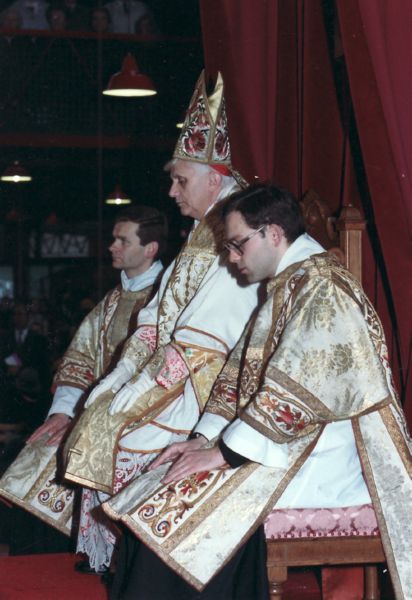
*

*

*
Liturgical gloves (chirothecœ, called also at an earlier date manicœ, wanti,) are a liturgical adornment reserved for bishops and cardinals. They are worn only at a Pontifical Mass, never at any other function, and then only to the washing of the hands before the Sacrifice.
*

*
The colour of the gloves must correspond with the liturgical colour of the feast or day in the services of which they are worn; episcopal gloves, however, are never black, as they are not used on Good Friday nor at the celebration of Masses for the dead. The chief reason for the introduction of the usage was probably the desire to provide a suitable adornment for the hands of the Bishop, rather than practical considerations such as the preservation of the cleanliness of the hands, etc.
*

*
Episcopal gloves are symbolical of purity from sin, the performance of good works, and carefulness of procedure.
*

*
The Cæremoniale Episcoporum, as revised in 1984, no longer imposes on Bishops of the Roman Catholic Church the use of episcopal gloves when celebrating Mass solemnly, but they are still used in such celebrations of the Tridentine Mass form of the Roman Rite.
*

*
The pontifical gloves are made of silk, and variously ornamented according to the solemnity of the occasion and the wearer’s rank and dignity. For Cardinals, Prelates invested with the episcopal character and Abbots, the back of the glove is embroidered with a more or less elaborate cross or monogram; and the Protonotaries Apostolic of the first two classes (di numero and supernumerary) may wear pontifical gloves of silk bordered with a strip of gold braid; but for all other Protonotaries, Prelates and Canons, who may be allowed, by law or privilege, the use of the pontificals, the gloves must be of plain silk without any special ornament.
*
*
(Source for previous information: Catholic Encyclopedia on-line)
†
According to Mgr. Nabuco, the liturgical gloves and the sandals always go together and when it is not permitted to wear the chirothecæ, then it is not permitted to wear the episcopal sandals, either.
*
 *
*He also says that the chirothecæ of protonoraries should not have any kind of ornamentation except a simple golden braid on the (border of the) cuffs. (It seems, though, that these rule was not followed and all liturgical gloves were decorated regardless of who was going to wear them).
*

*
And here is what Nainfa has to say:
"The pontifical gloves are made of silk, and variously ornamented according to the solemnity of the occasion and the wearer s rank and dignity. For Cardinals, Prelates invested with the Episcopal character and Abbots, the back of the glove is embroidered with a more or less elaborate cross or monogram; and the Protonotaries Apostolic of the first two classes (di numero and supernumerary) may wear pontifical gloves of silk bordered with a strip of gold braid; but for all other Protonotaries, Prelates and Canons, who may be allowed, by law or privilege, the use of the pontificals, the gloves must be of plain silk without any special ornament. (Sort of like this picture, but without the circle in the back of hand)."
*

*

 *
* *
* *
*
 *
* *
* *
*
 *
*





 *
*
